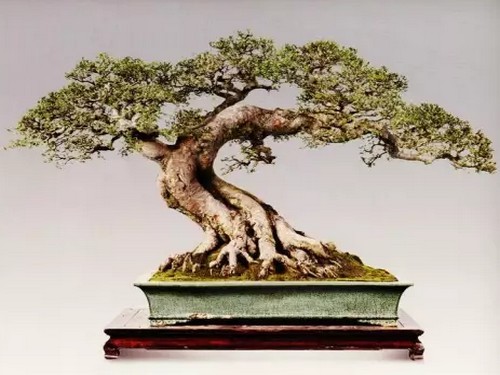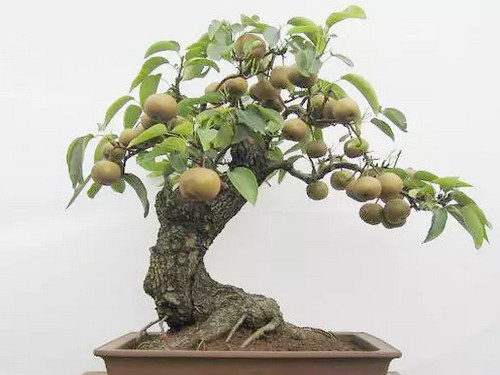Selection and cultivation of primrose bonsai
Spring jasmine is the "spring flower" of early spring. She grew in the courtyard wall or roadside flower bed, and not conspicuous, until the beginning of the new year, she opened her arms into the embrace of spring, the first to open flowers to meet the brilliant spring. However, she is not self-reliant, not proud, not to celebrate the spring meritorious self-dazzle, but with the flowers together with the common embellishment of spring, blooming stamens spit fragrance.
The flowering branches of Yingchun are small and supple, the root system is developed, the germination is strong, the pruning is resistant, the green calyx of Yingchun is gorgeous and funny, and it is a good bonsai material. Spring jasmine sprout strong, but also can be used to separate the propagation of plants. Cultivation of winter jasmine bonsai materials, should be first planted on the spot, pruning from time to time, so that a single stem, showing old state, and then planted in pots.

The materials for making winter jasmine bonsai are mainly artificial cultivation and excavation of sturdy old piles in the field, because of their pruning resistance and strong germination. After the plant grows to about 0.3 meters or a certain design requirement, the terminal bud can be cut off and a certain crown can be cultivated by heavy cutting method. Or through a certain shaping pruning, at any time to remove the root of the basal bud, promote its multi-branched flowering.
Artificial reproduction:
Cuttings, ramets, layering and other methods are usually used for propagation. Cuttage is simple and easy, survival rate is high, in February to March to select a strong annual branches for cuttings, or in the plum season with semi-mature cuttings can also be. Cut the cuttings into 10~15 cm, the lower end is even, the insertion depth is 2B3, the soil is pressed after insertion, the water is poured thoroughly, some broken straw is covered on the seedbed, the soil is kept moist, and the roots can be taken in about the middle and late April. From June to July, thin cake fertilizer water is applied several times to promote growth, and it can be transplanted in the spring of the next year.
Field excavation:
Field excavation should be based on root protection, try to maintain complete root system, remove disabled and dead root system, straighten out root system, plant deeply in pot, and gradually implement root extraction. The method of root extraction is to fill the lower part of the pot with nutrient soil and fill the upper part with fine sand soil. Cultivation should first be buried in the root basin, and then compacted, watered, and fine management.
After a period of cultivation, the root system developed normally, and fibrous roots grew in the culture soil, which had deep roots and luxuriant leaves. At this time, fine sand can be gradually removed, so that the upper roots are slowly exposed. After a certain period of culture, the exposed roots have gradually aged, and the lateral roots are also relatively strong. At this time, flowers and trees can be moved to shallow pots. The root system should be fully protected when transplanting, and the original culture soil should be taken. This can gradually cultivate a hanging root claw, simple vigorous winter jasmine bonsai.
Time: 2019-06-02 Click:
- Prev

Material selection and cultivation of Pushu bonsai
Pu Shu's posture is quaint and chic, the bark is uncracked, the stem shape is tall and straight, the branches are whirling, the new leaves are released at the beginning of spring, the branches are green, and the leaves are dark yellow in autumn. The fallen leaves are almost gone in winter, which can be enjoyed as a cold tree. Take its old tree stump, exposed roots and dry, Qiu qu simple, green leaves branches, cascading towering, very rich mountain forest wild interest
- Next

Selection of pear bonsai
Pear trees are suitable for making many different forms of bonsai, such as direct dry type, oblique dry type, curved dry type, double dry type, jungle type, facing water type, horizontal dry type and so on. The root system of pear tree is well developed, which can be raised according to the need to increase the artistic conception of the vicissitudes of bonsai. There are many rootstocks suitable for pear, such as mountain pear, du pear and so on.
Related
- Fuxing push coffee new agricultural production and marketing class: lack of small-scale processing plants
- Jujube rice field leisure farm deep ploughing Yilan for five years to create a space for organic food and play
- Nongyu Farm-A trial of organic papaya for brave women with advanced technology
- Four points for attention in the prevention and control of diseases and insect pests of edible fungi
- How to add nutrient solution to Edible Fungi
- Is there any good way to control edible fungus mites?
- Open Inoculation Technology of Edible Fungi
- Is there any clever way to use fertilizer for edible fungus in winter?
- What agents are used to kill the pathogens of edible fungi in the mushroom shed?
- Rapid drying of Edible Fungi

